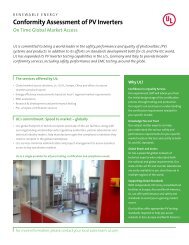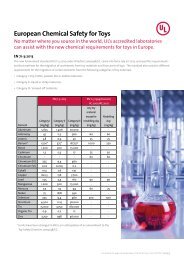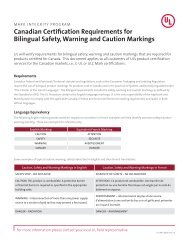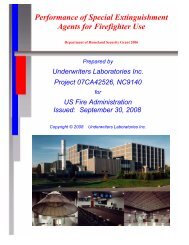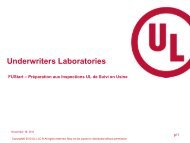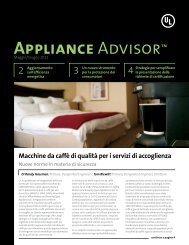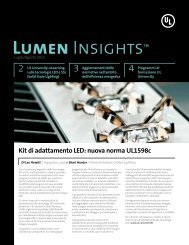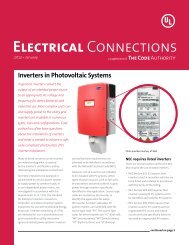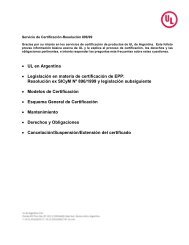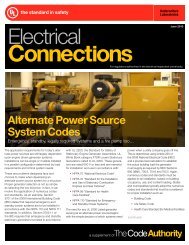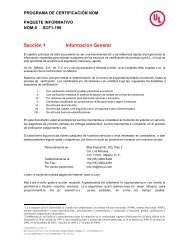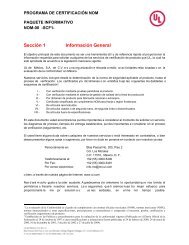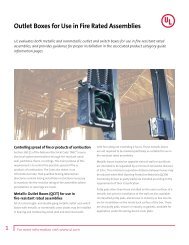UL AECO Program-Information for Suppliers _2010-04-29_ - UL.com
UL AECO Program-Information for Suppliers _2010-04-29_ - UL.com
UL AECO Program-Information for Suppliers _2010-04-29_ - UL.com
You also want an ePaper? Increase the reach of your titles
YUMPU automatically turns print PDFs into web optimized ePapers that Google loves.
<strong>UL</strong> <strong>AECO</strong> <strong>Program</strong>-<strong>In<strong>for</strong>mation</strong> <strong>for</strong> <strong>Suppliers</strong><br />
Issued: 2009-<strong>04</strong>-23<br />
Revised: <strong>2010</strong>-<strong>04</strong>-<strong>29</strong><br />
Page 1 of 9<br />
<strong>UL</strong> Accredited Elevator/Escalator Certification<br />
Organizations (<strong>AECO</strong>) <strong>Program</strong><br />
GENERAL INFORMATION FOR SUPPLIERS<br />
1. PROGRAM<br />
2. PROGRAM SCOPE<br />
3. SERVICE OFFERING<br />
4. SERVICE ACCEPTANCE<br />
5. REQUIREMENTS<br />
6. CERTIFICATION PROCEDURES<br />
GENERAL<br />
GENERAL SERVICES AGREEMENT (GSA) AND THE <strong>AECO</strong> PROGRAM TERMS AND CONDITIONS<br />
GLOBAL ESSENTIAL SAFETY REQUIREMENT (GESR)<br />
CODE COMPLIANCE DOCUMENT (CCD)<br />
CERTIFICATION OF SUB-SYSTEMS, COMPONENTS, OR FUNCTIONS<br />
CERTIFICATION OF ELEVATOR SYSTEMS<br />
7. SURVEILLANCE<br />
GENERAL<br />
SURVEILLANCE DETAILS<br />
SURVEILLANCE TESTING<br />
8. ABOUT <strong>UL</strong><br />
1. PROGRAM<br />
“Certification of Sub-Systems, Components, or Functions” is the procedure whereby the <strong>UL</strong><br />
<strong>AECO</strong> certifies that a representative sample of a sub-system, <strong>com</strong>ponent, or function of an<br />
elevator system will permit the elevator system to satisfy the relevant requirements of 2.2.1(b)<br />
or (c) of ASME A17.7-2007/CSA B44.7-07, Per<strong>for</strong>mance-based Safety Code <strong>for</strong> Elevators<br />
and Escalators, provided the sub-system, <strong>com</strong>ponent, or function is correctly fitted to the<br />
elevator system as specified in the manufacturer’s Code Compliance Document (CCD).<br />
“Certification of Elevator System” is the procedure whereby the <strong>UL</strong> <strong>AECO</strong> certifies that an<br />
elevator system satisfies the requirements of 2.2.1(b) or (c) of ASME A17.7-2007/CSA B44.7-<br />
07, Per<strong>for</strong>mance-based Safety Code <strong>for</strong> Elevators and Escalators.<br />
Additional in<strong>for</strong>mation related to the <strong>UL</strong> <strong>AECO</strong> certification program can be found in the<br />
“program guide in<strong>for</strong>mation” under the category code “<strong>AECO</strong>” on www.ul.<strong>com</strong> under<br />
“certifications”.<br />
Certified products and systems, including previously certified products and systems that have<br />
been WITHDRAWN are found under the category code “<strong>AECO</strong>” on www.ul.<strong>com</strong> under<br />
“certifications”.
<strong>UL</strong> <strong>AECO</strong> <strong>Program</strong>-<strong>In<strong>for</strong>mation</strong> <strong>for</strong> <strong>Suppliers</strong><br />
Issued: 2009-<strong>04</strong>-23<br />
Revised: <strong>2010</strong>-<strong>04</strong>-<strong>29</strong><br />
2. PROGRAM SCOPE<br />
The safety of an elevator system, sub-system, <strong>com</strong>ponent, or function is established by one<br />
of the following processes:<br />
Option 1 — Con<strong>for</strong>m to the requirements in ASME A17.1 or CSA B44. This is the<br />
conventional process used by implementing the ASME A17.1/CSA B44 Codes.<br />
Option 2 — Con<strong>for</strong>m to some of the requirements in ASME A17.1 or CSA B44 and <strong>for</strong><br />
elevator systems, sub-systems, <strong>com</strong>ponents, or functions that do not con<strong>for</strong>m to certain<br />
requirements in ASME A17.1 or CSA B44, con<strong>for</strong>m to the applicable requirements of ASME<br />
A17.7/CSA B44.7. This is the most <strong>com</strong>mon process <strong>for</strong> innovative design or use of new<br />
technology. The elevator system, sub-system, <strong>com</strong>ponent, or function will typically meet most<br />
requirements of ASME A17.1 or CSA B44; however, it may have certain design or other<br />
features or <strong>com</strong>ponents not covered by, or which deviate from, ASME A17.1 or CSA B44<br />
prescriptive requirements but con<strong>for</strong>m to applicable GESRs.<br />
Option 3 — Con<strong>for</strong>m to the requirements of ASME A17.7/CSA B44.7. This provides the<br />
alternative of achieving safety by satisfying all the applicable GESRs. The option is useful<br />
when the elevator system, sub-system, <strong>com</strong>ponent, or function is radically different from that<br />
addressed by ASME A17.1 or CSA B44 requirements. In this case, all applicable<br />
requirements of the GESRs shall be con<strong>for</strong>med to.<br />
This <strong>Program</strong> (The <strong>UL</strong> <strong>AECO</strong> <strong>Program</strong>) provides certification <strong>for</strong> the processes described in<br />
Options 2 and 3.<br />
3. SERVICE OFFERING<br />
<strong>UL</strong>, as an Accredited Elevator and Escalator Certification Organization (<strong>AECO</strong>) provides third<br />
party verification of:<br />
a) Evaluation of elevator and escalator systems, subsystems, <strong>com</strong>ponents and functions<br />
<strong>for</strong> con<strong>for</strong>mance with equivalent safety to the A17.1/B44 using the processes and procedures<br />
allowed by A17.7/B44.7.<br />
b) Continued surveillance of the manufacture of approved designs of systems,<br />
subsystems, <strong>com</strong>ponents and functions to ensure they continue to meet the requirements<br />
A17.7/B44.7 throughout the product life cycle.<br />
A17.7/B44.7 provides an alternative process to the ASME A17.1 and CSA B44 Codes <strong>for</strong><br />
establishing elevator safety. It includes a structured methodology <strong>for</strong> establishing,<br />
documenting, and demonstrating that necessary and appropriate protective measures are<br />
taken to minimize hazards or sufficiently mitigate risks. This process is particularly useful <strong>for</strong><br />
establishing safety of elevator systems, sub-systems, <strong>com</strong>ponents, or functions involving<br />
innovative design and new technologies.<br />
Page 2 of 9
<strong>UL</strong> <strong>AECO</strong> <strong>Program</strong>-<strong>In<strong>for</strong>mation</strong> <strong>for</strong> <strong>Suppliers</strong><br />
Issued: 2009-<strong>04</strong>-23<br />
Revised: <strong>2010</strong>-<strong>04</strong>-<strong>29</strong><br />
A product or system that has been found to <strong>com</strong>ply with all of the elements of this program is<br />
issued a Certificate of Con<strong>for</strong>mance to ASME A17.7/CSA B44.7 Mandatory Appendix I-3 <strong>for</strong><br />
sub-systems, <strong>com</strong>ponents, or functions or Mandatory Appendix I-4 <strong>for</strong> an elevator system,<br />
whichever is applicable.<br />
4. SERVICE ACCEPTANCE<br />
The American National Standards Institute (ANSI) accredits <strong>UL</strong>’s Accredited Elevator and<br />
Escalator Certification Organization (<strong>AECO</strong>) certification program.<br />
5. REQUIREMENTS<br />
The basic standards used to investigate products in this category are:<br />
ASME A17.1/CSA B44, Safety Code <strong>for</strong> Elevators and Escalators<br />
ASME A17.5/CSAB44.1, Standard <strong>for</strong> Elevator and Escalator Electrical Equipment<br />
ASME A17.7-2007/CSA B44.7-07, Per<strong>for</strong>mance-based safety code <strong>for</strong> elevators and<br />
escalators<br />
ISO/TS 22559-1 – Safety requirements <strong>for</strong> lifts (elevators) – Part 1, Global essential safety<br />
requirements (GESRs) <strong>for</strong> lifts (elevators)<br />
6. CERTIFICATION PROCEDURES<br />
GENERAL<br />
A product certification review is initiated by the submittal, by the Supplier or his<br />
representative, of a <strong>com</strong>pleted Application (appropriate program application <strong>for</strong>m and all<br />
of the in<strong>for</strong>mation required under the program regulations such as test data,<br />
photographs, schematics, attachments, exhibits, etc.) signed by a duly authorized<br />
representative of the Supplier.<br />
GENERAL SERVICES AGREEMENT (GSA) AND THE <strong>AECO</strong> PROGRAM TERMS AND<br />
CONDITIONS<br />
Both the Global Services Agreement and program terms and conditions are incorporated in<br />
the quotation provided to customers. The Global Services Agreement, program terms and<br />
conditions, and the quotation together constitute the entire agreement governing the delivery<br />
of requested services by Underwriters Laboratories Inc., and its subsidiaries and affiliates<br />
(<strong>UL</strong>). The GSA and Terms and Conditions are available at:<br />
http://programmes.ul-europe.<strong>com</strong>/en/index.php<br />
Be<strong>for</strong>e you begin your project, <strong>UL</strong> encourages you to review the program terms and<br />
conditions covering the service you’ve requested. Please print a copy of the program terms<br />
and conditions <strong>for</strong> your project records.<br />
Page 3 of 9
<strong>UL</strong> <strong>AECO</strong> <strong>Program</strong>-<strong>In<strong>for</strong>mation</strong> <strong>for</strong> <strong>Suppliers</strong><br />
Issued: 2009-<strong>04</strong>-23<br />
Revised: <strong>2010</strong>-<strong>04</strong>-<strong>29</strong><br />
The GSA and <strong>Program</strong> Terms and Conditions contain required program in<strong>for</strong>mation and<br />
impose the following Supplier obligations and requirements:<br />
a. The Supplier’s corporate entity, name, address and legal status;<br />
b. Compliance with provisions of the product certification program shall be maintained at<br />
all times;<br />
c. Certification shall only be used to assure products are in con<strong>for</strong>mity with specific<br />
requirements;<br />
d A statement that the Supplier agrees to <strong>com</strong>ply with requirements <strong>for</strong> the certification<br />
being sought and to supply any in<strong>for</strong>mation needed <strong>for</strong> evaluation of products to be certified;<br />
e. Arrangements necessary <strong>for</strong> the conduct of all required evaluations shall be made,<br />
including access to all facilities, records, documents, in<strong>for</strong>mation, product samples and<br />
personnel <strong>for</strong> the purpose of evaluation and resolution of <strong>com</strong>plaints;<br />
e. Certification shall not be used in a misleading or unauthorized manner;<br />
f. Claims regarding certification shall only be made <strong>for</strong> the scope and product(s) <strong>for</strong><br />
which certification was specifically granted;<br />
g. References to certification shall not be used in a misleading or unauthorized manner.<br />
h. Certification documents shall not be used in a misleading or unauthorized manner;<br />
In the event of suspension (if used) or withdrawal of certification, use of certification<br />
documents shall be discontinued; references to certification shall be removed from all<br />
advertising or promotional material; and certification documents shall be returned if<br />
necessary to prevent misrepresentation of non-certified products;<br />
i. Cooperation with the required <strong>UL</strong> <strong>AECO</strong> surveillance programs.<br />
j. Maintain records of <strong>com</strong>plaints received concerning certified products.<br />
k. Notification to the <strong>UL</strong> <strong>AECO</strong> of any changes that affect the con<strong>for</strong>mity of certified<br />
products as a condition of certification. If further evaluation activities are needed, the Supplier<br />
is prohibited from releasing certified products until authorized by the <strong>UL</strong> <strong>AECO</strong>.<br />
l. To provide <strong>UL</strong> <strong>AECO</strong> with a written declaration that the same application has not been<br />
submitted to any other <strong>AECO</strong>, or a written explanation as to why the application is being<br />
submitted to another <strong>AECO</strong>.<br />
GLOBAL ESSENTIAL SAFETY REQUIREMENT (GESR)<br />
Globally agreed-upon essential safety requirement based on ISO/TS 22559-1 – Safety<br />
requirements <strong>for</strong> lifts (elevators) – Part 1 – Global essential safety requirements (GESRs) <strong>for</strong><br />
lifts (elevators). A GESR states only the safety objective, or “what” shall be done or<br />
ac<strong>com</strong>plished, but not “how” to ac<strong>com</strong>plish the objective. To ac<strong>com</strong>plish the safety objective<br />
of a GESR, elevator systems, sub-systems, <strong>com</strong>ponents, or functions and safety parameters<br />
(SPs) that are used shall be capable of eliminating or sufficiently mitigating safety risks<br />
addressed in the GESR.<br />
CODE COMPLIANCE DOCUMENT (CCD)<br />
A CCD shall be produced <strong>for</strong> each design of an elevator system, sub-system, <strong>com</strong>ponent, or<br />
function <strong>for</strong> which safety has been assessed <strong>for</strong> con<strong>for</strong>mance with ASME A17.7-2007/CSA<br />
B44.7-07, Per<strong>for</strong>mance-based Safety Code <strong>for</strong> Elevators and Escalators.<br />
The CCD shall include:<br />
(a) an overall description of equipment;<br />
(b) a description of particular elevator system, sub-system, <strong>com</strong>ponent, or function <strong>for</strong> which<br />
certification is desired;<br />
Page 4 of 9
<strong>UL</strong> <strong>AECO</strong> <strong>Program</strong>-<strong>In<strong>for</strong>mation</strong> <strong>for</strong> <strong>Suppliers</strong><br />
Issued: 2009-<strong>04</strong>-23<br />
Revised: <strong>2010</strong>-<strong>04</strong>-<strong>29</strong><br />
(c) a list of ASME A17.1 or CSA B44 Parts, Sections, or requirements that have been<br />
addressed by <strong>com</strong>pliance with ASME A17.7/CSA B44.7;<br />
(d) technical documentation necessary to demonstrate con<strong>for</strong>mity and enable verification of<br />
con<strong>for</strong>mance;<br />
(e) a list of GESRs considered;<br />
(f) a risk assessment report, including team members, their relevant expertise and<br />
experience, and date of <strong>com</strong>pletion of the risk assessment processes;<br />
(g) procedures <strong>for</strong> acceptance inspections and tests to verify con<strong>for</strong>mance with CCD; and<br />
(h) procedures <strong>for</strong> tests, periodic inspections, maintenance, replacements, adjustments, and<br />
repairs to be incorporated into and made a part of the maintenance control program (MCP)<br />
required by ASME A17.1 or CSA B44, requirement 8.6.1.2.1.<br />
CERTIFICATION OF SUB-SYSTEMS, COMPONENTS, OR FUNCTIONS<br />
Application<br />
The application <strong>for</strong> Certification of Sub-Systems, Components, or Functions shall be<br />
submitted by the applicant or an authorized representative to <strong>UL</strong> <strong>AECO</strong>. The application shall<br />
include:<br />
(a) the name and address of applicant;<br />
(b) the name and address of the manufacturer of the sub-system, <strong>com</strong>ponent, or function or<br />
the authorized representative and the place of manufacture of the sub-system, <strong>com</strong>ponent, or<br />
function;<br />
(c) a written declaration that the same application has not been submitted to any other<br />
<strong>AECO</strong>, or a written explanation as to why the application is being submitted to another<br />
<strong>AECO</strong>;<br />
(d) technical documentation (see below); and<br />
(e) a representative sample(s) of the sub-system, <strong>com</strong>ponent, or function, or details of the<br />
place where it can be examined.<br />
Technical documentation<br />
Technical documentation shall be provided <strong>for</strong> <strong>UL</strong> <strong>AECO</strong> to assess the con<strong>for</strong>mity of a subsystem,<br />
<strong>com</strong>ponent, or function when it is correctly fitted as specified in the manufacturer’s<br />
CCD.<br />
The technical documentation shall include the following:<br />
(a) CCD (see details above);<br />
(b) a general description of the sub-system, <strong>com</strong>ponent, or function, including its intended<br />
use (possible limitations such as speed, load, power, etc.) and conditions affecting use (such<br />
as explosive environments, exposure to the elements, etc.);<br />
(c) design and manufacturing drawings or diagrams;<br />
(d) GESRs taken into consideration and the means adopted to con<strong>for</strong>m;<br />
(e) results of all applicable tests or calculations per<strong>for</strong>med or subcontracted by the applicant<br />
or manufacturer;<br />
(f) a copy of the assembly instructions <strong>for</strong> the sub-system, <strong>com</strong>ponent, or function; and<br />
(g) steps taken at the manufacturing stage to ensure that the series-produced sub-system,<br />
<strong>com</strong>ponent, or functions con<strong>for</strong>m to the sub-system, <strong>com</strong>ponent, or function examined.<br />
Page 5 of 9
<strong>UL</strong> <strong>AECO</strong> <strong>Program</strong>-<strong>In<strong>for</strong>mation</strong> <strong>for</strong> <strong>Suppliers</strong><br />
Issued: 2009-<strong>04</strong>-23<br />
Revised: <strong>2010</strong>-<strong>04</strong>-<strong>29</strong><br />
Certification Process<br />
<strong>UL</strong> <strong>AECO</strong> will<br />
(a) examine the technical documentation to verify that the sub-system, <strong>com</strong>ponent, or<br />
function meets the relevant GESRs; and<br />
(b) per<strong>for</strong>m or have per<strong>for</strong>med appropriate checks and tests necessary to determine whether<br />
the solutions adopted by the manufacturer of the sub-system, <strong>com</strong>ponent, or function meet<br />
the requirements, allowing the sub-system, <strong>com</strong>ponent, or function to carry out its function<br />
when correctly fitted on an elevator as specified in the manufacturer’s CCD.<br />
When <strong>UL</strong> <strong>AECO</strong> confirms that the representative sub-system, <strong>com</strong>ponent, or function<br />
con<strong>for</strong>ms to the applicable requirements, <strong>UL</strong> issues a Certificate of Con<strong>for</strong>mance to the<br />
applicant. The certificate and ac<strong>com</strong>panying documents, if any, includes the following:<br />
(a) the name and address of the manufacturer of the sub-system, <strong>com</strong>ponent, or function and<br />
the name and address of the applicant, if other than the manufacturer;<br />
(b) the scope of the certification, including, as appropriate:<br />
(1) product(s) certified, which shall be permitted to be identified by type or range of<br />
products;<br />
(2) relevant parts of the requirements (such as GESRs, SPs, etc.) to which each<br />
product or product type is certified;<br />
(3) statement of <strong>com</strong>pliance with ASME A17.7/CSA B44.7; and<br />
(c) the effective date of the certificate and the term (time limit) or expiration date.<br />
If <strong>UL</strong> refuses to issue a Certificate of Con<strong>for</strong>mance based on a non-<strong>com</strong>pliance, <strong>UL</strong> will state<br />
the detailed grounds <strong>for</strong> refusal. If you have any questions about your test results, the<br />
interpretation of a requirement or any <strong>UL</strong> decision, the <strong>UL</strong> appeals procedure provides a<br />
method <strong>for</strong> your concerns to be heard by <strong>UL</strong> management without jeopardizing your<br />
relationship with <strong>UL</strong>. Just contact customer service or our engineering staff <strong>for</strong> details.<br />
Marking of Sub-Systems and Components<br />
The elevator sub-system or <strong>com</strong>ponent shall be labeled, marked, or tagged with the following<br />
data:<br />
(a) the name or trademark of the manufacturer, or <strong>UL</strong> <strong>AECO</strong> Certificate of Con<strong>for</strong>mance<br />
Identification by which the organization that manufactured the device can be identified;<br />
(b) the <strong>UL</strong> Classification mark;<br />
(c) the <strong>UL</strong> <strong>AECO</strong> Certificate of Con<strong>for</strong>mance identification;<br />
(d) statement of <strong>com</strong>pliance with ASME A17.7/CSA B44.7;<br />
(e) a distinctive type, model, or style letter or number; and<br />
(f) any conditions of validity of the certificate and any particulars necessary to identify the type<br />
of <strong>com</strong>ponent certified, as determined by the <strong>UL</strong>.<br />
Applicant Responsibilities<br />
An applicant who has received a Certificate of Con<strong>for</strong>mance <strong>for</strong> a sub-system, <strong>com</strong>ponent, or<br />
function is required to in<strong>for</strong>m <strong>UL</strong> in writing of any modifications to the sub-system,<br />
<strong>com</strong>ponent, or function that could affect the safety of the system in which it is applied. <strong>UL</strong> will<br />
examine the modifications and in<strong>for</strong>m the applicant whether the Certificate of Con<strong>for</strong>mance<br />
remains valid.<br />
Page 6 of 9
<strong>UL</strong> <strong>AECO</strong> <strong>Program</strong>-<strong>In<strong>for</strong>mation</strong> <strong>for</strong> <strong>Suppliers</strong><br />
Issued: 2009-<strong>04</strong>-23<br />
Revised: <strong>2010</strong>-<strong>04</strong>-<strong>29</strong><br />
CERTIFICATION OF ELEVATOR SYSTEMS<br />
Application<br />
The application <strong>for</strong> “Certification of Elevator System” shall be submitted by the applicant or an<br />
authorized representative to <strong>UL</strong> <strong>AECO</strong>.<br />
The application shall include:<br />
(a) the name and address of the applicant or the authorized representative and the place of<br />
manufacture of the elevator system;<br />
(b) a written declaration that the same application has not been submitted to any other<br />
<strong>AECO</strong>, or a written explanation as to why the application is being submitted to another<br />
<strong>AECO</strong>;<br />
(c) technical documentation (see below); and<br />
(d) details of the location where the elevator system can be examined. The elevator system<br />
submitted <strong>for</strong> examination and certification must include all parts and be capable of serving at<br />
least three levels (top, middle and bottom) unless the system is specifically limited in scope to<br />
a two-stop application.<br />
Technical Documentation<br />
The technical documentation shall provide sufficient understanding of the design and<br />
operation of the elevator system to facilitate verification of its con<strong>for</strong>mity to the requirements.<br />
The technical documentation shall include the following:<br />
(a) CCD (see above);<br />
(b) a general description of the elevator systems indicating all possible extensions to the<br />
elevator system under examination (see also definition of “model elevator”);<br />
(c) design and manufacturing drawings or diagrams;<br />
(d) GESRs taken into consideration and means adopted to satisfy them;<br />
(e) results of any tests or calculations per<strong>for</strong>med or subcontracted by the manufacturer,<br />
applicant, or installer; and<br />
(f) steps taken at the installation stage to ensure that the elevator system con<strong>for</strong>ms to the<br />
requirements.<br />
Certification Process<br />
The <strong>AECO</strong> will:<br />
(a) examine the technical documentation to verify that the elevator system meets the relevant<br />
GESRs; and<br />
(b) per<strong>for</strong>m or have per<strong>for</strong>med the appropriate checks and tests necessary to determine that<br />
the elevator system meets the requirements.<br />
When <strong>UL</strong> <strong>AECO</strong> confirms that the elevator system <strong>com</strong>plies with the applicable requirements<br />
of this Code, <strong>UL</strong> will issue a Certificate of Con<strong>for</strong>mance to the applicant. The certificate and<br />
related documents shall include the following:<br />
(a) the name and address of the supplier whose products are the subject of certification.<br />
(b) the scope of the certification, including, as appropriate:<br />
(1) products certified, which shall be permitted to be identified by type or range of<br />
products;<br />
(2) relevant parts of this Code to which each product or product type is certified;<br />
(3) statement of <strong>com</strong>pliance with ASME A17.7/CSA B44.7; and<br />
(c) the effective date of the certificate and the term (time limit) or expiration date.<br />
Page 7 of 9
<strong>UL</strong> <strong>AECO</strong> <strong>Program</strong>-<strong>In<strong>for</strong>mation</strong> <strong>for</strong> <strong>Suppliers</strong><br />
Issued: 2009-<strong>04</strong>-23<br />
Revised: <strong>2010</strong>-<strong>04</strong>-<strong>29</strong><br />
If <strong>UL</strong> <strong>AECO</strong> refuses to issue a Certificate of Con<strong>for</strong>mance based on a non-<strong>com</strong>pliance <strong>UL</strong> will<br />
state the detailed grounds <strong>for</strong> refusal. If you have any questions about your test results, the<br />
interpretation of a requirement or any <strong>UL</strong> decision, the <strong>UL</strong> appeals procedure provides a<br />
method <strong>for</strong> your concerns to be heard by <strong>UL</strong> management without jeopardizing your<br />
relationship with <strong>UL</strong>. Just contact customer service or our engineering staff <strong>for</strong> details.<br />
Applicant Responsibilities<br />
An applicant who has received a Certificate of Con<strong>for</strong>mance <strong>for</strong> an elevator system is<br />
required to in<strong>for</strong>m <strong>UL</strong> <strong>AECO</strong> in writing of any modifications that could affect the safety of the<br />
system. <strong>UL</strong> will examine the modifications and in<strong>for</strong>m the applicant whether the Certificate of<br />
Con<strong>for</strong>mance remains valid.<br />
7. SURVEILLANCE<br />
GENERAL<br />
The <strong>Program</strong>’s surveillance system is called Follow-Up Service (FUS). <strong>UL</strong> <strong>AECO</strong><br />
Classification services are covered by <strong>UL</strong>’s Type R (Re-Examination) Follow-Up Service. The<br />
frequency of countercheck (audits) is established at quarterly (4 per year). Certified product<br />
inspections (product audits) may include or address (but not necessarily at each inspection)<br />
at least the following elements:<br />
• physical examination of the product<br />
• selecting samples <strong>for</strong> counter check tests (when such testing is required)<br />
• verifying proper conduct and record keeping of factory required tests<br />
• confirming use of approved <strong>com</strong>ponents<br />
• monitoring manufacturer’s control of the <strong>UL</strong> Mark<br />
• monitoring calibration of equipment used <strong>for</strong> factory required tests<br />
SURVEILLANCE DETAILS<br />
Because of the potential uniqueness of every submission <strong>for</strong> a certification, the <strong>UL</strong> <strong>AECO</strong><br />
will, in most cases, establish the requirements <strong>for</strong> the sample selection, models and<br />
frequency and specific test methods <strong>for</strong> the Ongoing (Production Testing – if required) and<br />
Follow-Up testing <strong>for</strong> each product being certified. Where applicable, products may be<br />
grouped together into "groups" based on electrical and/or mechanical attributes that<br />
characterize these products. Samples are selected from each model no., catalog no. or<br />
"group" so that representative samples of all the manufacturer's <strong>AECO</strong> Certified products are<br />
selected on a periodic basis.<br />
SURVEILLANCE TESTING<br />
The test methods used in both Ongoing and Follow-Up testing are usually the same as used<br />
in the Initial Evaluation, though test programs <strong>for</strong> Ongoing and Follow-Up tests are typically<br />
not as extensive as those used <strong>for</strong> the initial certification.<br />
Page 8 of 9
<strong>UL</strong> <strong>AECO</strong> <strong>Program</strong>-<strong>In<strong>for</strong>mation</strong> <strong>for</strong> <strong>Suppliers</strong><br />
Issued: 2009-<strong>04</strong>-23<br />
Revised: <strong>2010</strong>-<strong>04</strong>-<strong>29</strong><br />
The frequency of Ongoing testing (if required) is established so that representative samples<br />
of all the manufacturer's <strong>AECO</strong> Certified products are selected on a periodic basis. The<br />
following conditions are considered when establishing the testing frequency <strong>for</strong> the product<br />
type:<br />
(A) Follow-Up and Inspection Instructions <strong>for</strong> similar products may be consulted to determine<br />
if sample selection and or testing frequency has been previously established <strong>for</strong> similar<br />
product types or technologies.<br />
(B) The average manufacturing production volume is to be considered when determining the<br />
testing frequency <strong>for</strong> the manufacturer's Ongoing Test <strong>Program</strong>. If the average production<br />
volume is constant, samples may be chosen based on time. For example, sample selection<br />
could be based on number of samples per day or shift. If the average production greatly<br />
varies, consideration should be given to establishing a sample selection based on production<br />
volume.<br />
8. ABOUT <strong>UL</strong><br />
<strong>UL</strong> operates under its own authority as an independent, not-<strong>for</strong>-profit, nongovernmental<br />
organization.<br />
The associated rights and responsibilities of <strong>UL</strong> and manufacturers are detailed in the various<br />
contractual agreements that must be executed prior to initiating the certification process.<br />
Additional in<strong>for</strong>mation is available on the Submittal Process page.<br />
<strong>UL</strong> is financially funded by the fees it charges manufacturers <strong>for</strong> evaluation and / or<br />
certification of their products. Fees are charged <strong>for</strong> the initial evaluation process, as well as<br />
ongoing maintenance fees <strong>for</strong> Follow-Up Service.<br />
A <strong>for</strong>mal Appeals Process is available to applicants to address questions concerning<br />
interpretations and decisions made by <strong>UL</strong> concerning submitted products. An appeal can be<br />
initiated by contacting Customer Service or the engineer that was involved with the project. A<br />
Field Report system is also available <strong>for</strong> reporting problems with certified products. Contact<br />
in<strong>for</strong>mation is available on the Consumer Affairs page. An online Field Report <strong>for</strong>m is also<br />
available.<br />
Page 9 of 9



